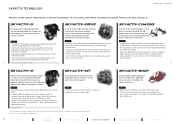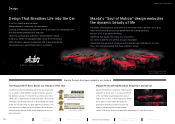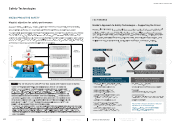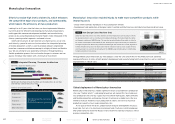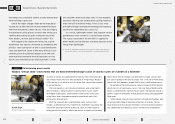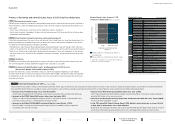Mazda 2016 Annual Report Download - page 23
Download and view the complete annual report
Please find page 23 of the 2016 Mazda annual report below. You can navigate through the pages in the report by either clicking on the pages listed below, or by using the keyword search tool below to find specific information within the annual report.
Safety Technologies
Mazda helps drivers drive safely by offering an ideal driving environment and stable handling.
When designing the layout of our vehicles, we start with the human being and place essen-
tials, such as the steering wheel, accelerator, and brake pedal, where they are easy to oper-
ate in a way that feels natural. This approach also makes driving safer and more enjoyable.
All Mazda vehicles aim to provide
Jinba-ittai
, or “horse and rider as one,” driving and correct
driving position forms the very foundation of achieving this feeling of unity. That’s why this
“human-centered” philosophy is at the root of every layout and design decision we make.
The accelerator is located precisely where the driver’s foot will reach naturally, without
the need to offset or twist the lower body. To make this possible, the front wheelhouse has
been moved forward on all new and redesigned models since the CX-5, a change that re-
flects Mazda’s commitment to designing its vehicles around the human beings that use
them. The adjustment range for the
seats and steering wheel is deter-
mined in order to have as many
drivers as possible to achieve their
ideal driving position regardless of
different body size or dispersion of
Eye-Line Zone.
Aiming at helping the driver concentrate on driving safely in a correct posture while dealing with
many kinds of information, this Human Machine Interface concept has achieved minimum visual
distraction and posture change.
• Simple cockpit with information sorted and placed in different zones
• A 7-inch center display installed on the dashboard, enabling the driver to view it without lower-
ing his/her eyes ➊
• Commander control pursuing operation that does not require a visible check of the driver’s hand
movements ➋
• Active driving display to present vehicle speed, navigation route, and other information as an
image in front of the meter hood ➌
• A voice-recognition system to control the functions by voice is also available
By positioning the A-pillar further rearward than most common cars, Mazda offers the driver
a wider field of forward visibility. Safe driving is further supported by a gap between the
A-pillar and door mirror large enough to enable objects positioned low down to be seen
easily from either the driver’s seat or the passenger’s seat.
With an organ-type accelerator pedal, the driver’s heel is placed
on the floor, and the driver’s foot and the pedal follow the same
trajectory. This makes accelerator pedal control easier because
the heel position is stabilized.
The accelerator pedal is positioned where the driver’s foot
naturally rests while sitting in the seat. This reduces both driving
fatigue and the chances of the driver stepping on the wrong pedal
when reacting quickly.
Achieving the Ideal Driving Position
Heads-Up Cockpit
Improved Forward Visibility
Organ-Type Accelerator Pedal
The ideal driving environment
Position of front wheel allows the ideal pedal layout
➊ Center Display ➋ Commander Control ➌ Active Driving Display
Comparison of diagonal front view with
different A-pillar shapes
Comparison of different door mirror
mounting positions
MAZDA ANNUAL REPORT 2016
21 Drivers of Value Creation
Message from
Management
Review of Operations
Foundations Underpinning
Sustainable Growth
Financial Section
Contents








